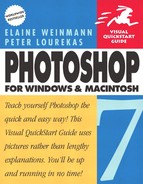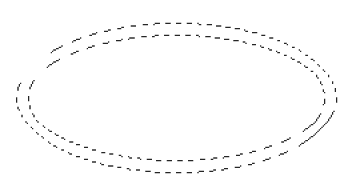When a layer or part of a layer is selected, only that area is editable—the rest of the image is protected. A selection border has a “marching ants” marquee. This chapter covers the creation of selections using the Rectangular Marquee, Elliptical Marquee, Lasso, Polygonal Lasso, Magic Wand, and Magnetic Lasso tools, as well as the Color Range and Extract commands. You will also learn how to create selections of various shapes; how to select by color; how to deselect, reselect, invert, or delete a selection; how to move or hide a selection marquee; how to transform, add to, or subtract from a selection; and how to create a vignette.
A selection contains pixels from whichever layer is currently active. If the Move tool is used to move a selection on the Background of an image, the current Background color will be applied automatically to the exposed area. If a selection is moved on a layer using the Move tool, the exposed area will become transparent. (See Chapter 7, “Layers.”)
Tip
A selection can be converted into a path for precise reshaping, and then converted back into a selection (see pages 284 and 294). Quick Masks, which function like selections but can be painted on an image, are covered in Chapter 15.
Choose a layer, then choose Select > All (Ctrl-A/Cmd-A). A marquee will surround the entire layer.
or
To select only opaque pixels—not any transparent areas—on a layer, Ctrl-click/Cmd-click the layer on the Layers palette ![]() –
–![]() . Or right-click/Ctrl-click a layer thumbnail and choose Select Layer Transparency.
. Or right-click/Ctrl-click a layer thumbnail and choose Select Layer Transparency.

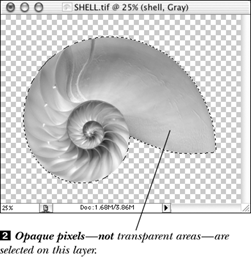
Choose a layer.
Choose the Rectangular Marquee
 or Elliptical Marquee tool (M or Shift-M). Or to create the thinnest possible selection, choose the Single Row Marquee or Single Column Marquee tool.
or Elliptical Marquee tool (M or Shift-M). Or to create the thinnest possible selection, choose the Single Row Marquee or Single Column Marquee tool.
Optional: To specify the exact dimensions of the selection, with the Rectangular or Elliptical Marquee tool highlighted, choose Fixed Size from the Style pop-up menu on the options bar
 , then enter Width and Height values. Remember though, you’re counting pixels based on the file’s resolution, not the monitor’s resolution, so the same Fixed Size marquee will appear larger in a low-resolution file than in a high-resolution file.
, then enter Width and Height values. Remember though, you’re counting pixels based on the file’s resolution, not the monitor’s resolution, so the same Fixed Size marquee will appear larger in a low-resolution file than in a high-resolution file.
To specify the width-to-height ratio of the selection (3-to-1, for example), choose Constrained Aspect Ratio from the Style pop-up menu, then enter Width and Height values. Enter the same value in both fields to create a circle or a square.
Optional: To soften the edges of the selection before it’s created, enter a Feather value above zero on the options bar
 . The Anti-aliased option can be checked on or off for the Elliptical Marquee tool.
. The Anti-aliased option can be checked on or off for the Elliptical Marquee tool.
If you specified Fixed Size values (or are using the Single Row or Single Column tool), click on the image. For any other Style, drag diagonally
 –
– . A marquee will appear. To create a square or a circular selection for the Normal Style, start dragging, then finish the marquee with Shift held down.
. A marquee will appear. To create a square or a circular selection for the Normal Style, start dragging, then finish the marquee with Shift held down.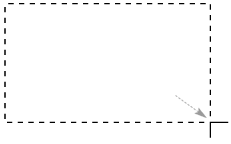
 Drag diagonally to create a rectangular selection...
Drag diagonally to create a rectangular selection...
 ...or an elliptical selection.
...or an elliptical selection.Hold down the spacebar to move the marquee while drawing it. To move the marquee after releasing the mouse, drag inside it.
Tip
As you drag the mouse, the dimensions of the selection will be indicated in the W and H areas on the Info palette.
Note: Since it’s difficult to precisely reselect an area (unless you save the selection in an alpha channel or as a path), try to refine your selection before you deselect it.
Choose a layer.
Choose the Lasso tool (L or Shift-L).

Optional: Enter a Feather value above zero on the Lasso tool options bar to soften the edges of the selection.
Drag around an area of the layer
 . When you release the mouse, the open ends of the selection will join automatically.
. When you release the mouse, the open ends of the selection will join automatically.
 A curved Lasso tool selection
A curved Lasso tool selection
Choose a layer.
Choose the Polygon Lasso tool (L or Shift-L).

To create straight sides, click to create points
 . To join the open ends of the selection, click on the starting point (a small circle will appear next to the pointer). Or Ctrl-click/Cmd-click or double-click anywhere on the image to have the selection close automatically.
. To join the open ends of the selection, click on the starting point (a small circle will appear next to the pointer). Or Ctrl-click/Cmd-click or double-click anywhere on the image to have the selection close automatically.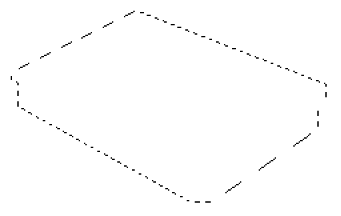
 A straight-edged Polygon Lasso tool selection
A straight-edged Polygon Lasso tool selectionAlt-drag/Option-drag to create a curved segment as you draw a polygonal selection. Release Alt/Option to resume drawing straight sides.
If you click on a layer pixel with the Magic Wand tool, a selection will be created that includes adjacent pixels of a similar shade, color, or transparency level to the one you clicked on. You can then add similarly colored, nonadjacent pixels to the selection using the Similar command, or add nonsimilar colors by Shift-clicking.
Choose a layer.
Choose the Magic Wand tool (W).

Check Contiguous on the Magic Wand tool options bar
 to limit the selection to areas that are connected to the first pixel you click on, or uncheck this option to select noncontiguous areas.
to limit the selection to areas that are connected to the first pixel you click on, or uncheck this option to select noncontiguous areas.
 The Magic Wand tool options bar
The Magic Wand tool options barOn the Magic Wand options bar, check Use All Layers to sample from colors in all the currently displayed layers in order to create the selection. Only pixels on the current layer can be edited, but you can apply changes within the same selected area through successive layers.
or
Uncheck Use All Layers to sample colors only on the current layer.
Also, check Anti-aliased, if desired, for a smoother selection edge.
Click on a shade or color in the image window.
Do any of these optional steps:
To enlarge the selection based on the current Tolerance setting on the Magic Wand options bar, choose Select > Grow as many times as you like (use a low Tolerance). You can also access this command by right-clicking/Ctrl-clicking in the image window.
To select additional, noncontiguous areas of similar color or shade based on the current Tolerance setting on the Magic Wand tool options bar, choose Select > Similar. You can also access this command by right-clicking/Ctrl-clicking in the image window.
To change the range of shades or colors within which the Magic Wand tool selects, enter a Tolerance value (0–255) on the Magic Wand tool options bar, then click on the image again. For example, at a Tolerance of 32, the Magic Wand will select within a range of 16 shades below and 16 shades above the shade it’s clicked on. Enter 0 to select only one color or shade.
To gradually expand or narrow the range of shades or colors the Magic Wand tool selects, modify the Tolerance value between clicks. The higher the Tolerance, the broader the range of colors the wand selects.

A selection created using the Magic Wand with a Tolerance of 10

A selection created using the Magic Wand with a Tolerance of 40: At a higher Tolerance, more pixels are selected.
Tip
To quickly select all the opaque and partially opaque pixels on a layer (not the Background or any fully transparent areas), Ctrl-click/Cmd-click the layer.
Tip
To Expand or Contract a selection by a specified number of pixels, choose either command from the Select > Modify submenu.
Tip
To remove a flat-color background from around a shape, first select the background of the image using the Magic Wand tool, then press Backspace/Delete.
In creating the Magnetic Lasso tool (and the Extract command, discussed on page 108), Adobe has tried to make the difficult task of selecting irregular shapes and furry, fuzzy, or complex edges a little easier. Neither technique solves the problem completely, but they’re useful tools nevertheless.
The Magnetic Lasso tool creates a free-form selection automatically as you move or drag the mouse. It snaps to the nearest distinct shade or color that defines the edge of a shape. Note: This tool utilizes a lot of processor time and RAM. If you move or drag the mouse quickly, the tool may not keep pace with you.
Choose the Magnetic Lasso tool (L or Shift-L).

Optional: Change any of the tool’s options bar settings. See “Magnetic Lasso tool options bar” on the next page.
Click to establish a fastening point. Move the mouse, with or without pressing the mouse button, along the edge of the shape that you want to select
 . As you move or drag the mouse, the selection line will snap to the edge of the shape. The temporary points that appear will disappear when you close the selection.
. As you move or drag the mouse, the selection line will snap to the edge of the shape. The temporary points that appear will disappear when you close the selection.
 Move the mouse slowly around a shape.
Move the mouse slowly around a shape.If the selection line starts to follow adjacent shapes that you don’t want to select, click on the edge of the shape that you do want to select to add a fastening point manually, then continue to move or drag to complete the selection.
To close the selection line:


 After closing the selection
After closing the selectionDouble-click anywhere over the shape.
or
Click the starting point (a small circle will appear next to the Magnetic Lasso tool pointer).
or
Press Enter/Return.
or
Ctrl-click/Cmd-click.
or
Alt-double-click/Option-double-click to close with a straight segment.
Choose a layer to be edited using the selection.
![]() The Magnetic Lasso tool options bar
The Magnetic Lasso tool options bar
The Feather amount is the softness of the edges of the selection.
The Width (1–40) is the size of the area in pixels under the pointer that the tool considers when it places a selection line ![]() . Use a wide Width for a high-contrast image that has strong edges. Use a narrow Width for an image that has subtle contrast changes or small shapes that are close together; the selection will be more precise and the line won’t flip-flop back and forth across the edge.
. Use a wide Width for a high-contrast image that has strong edges. Use a narrow Width for an image that has subtle contrast changes or small shapes that are close together; the selection will be more precise and the line won’t flip-flop back and forth across the edge.

Tip
To decrease the Width setting by one pixel as you create a selection, press “[”. To increase it, press “]”.
Edge Contrast (1–100) is the degree of contrast needed between shapes for an edge to be discerned. Use a low Edge Contrast for a low-contrast image.
Frequency (0–100) controls how often fastening points are placed as a selection is made. The lower the Frequency, the less frequently points are placed. Use a high Frequency to select an irregular contour.
Using the Color Range command, you can select areas based on colors in the image or based on a luminosity or hue range.
Choose a layer. The Color Range command samples colors from all the currently visible layers, but only the current layer will be available for editing. You can limit the selection range by creating a selection first.
Choose Select > Color Range.
Choose from the Select pop-up menu. You can limit the selection to a preset color range (e.g., Reds, Yellows), to a luminosity range (Highlights, Midtones, or Shadows), or to Sampled Colors (shades or colors you’ll click on with the Color Range eyedropper). The Out of Gamut option can only be used on an image that’s in Lab Color or RGB Color mode. If you choose a preset color range, and the image contains only light saturations of that color, an alert box will warn you that the selection marquee will be present but invisible.
Choose a Selection Preview option for previewing selection areas on the image.
To preview the selection, click the Selection button; to redisplay the whole image, click the Image button. Or hold down Ctrl/Cmd with either option chosen to toggle between the two. If the image extends beyond the edges of the image window, use the Image option; the entire image will be displayed in the preview box to facilitate sampling.
If you chose Sampled Colors in step 3, click or drag in the preview box or in the image window with the eyedropper cursor to sample colors in the image.
Optional: Move the Fuzziness slider to the right to expand the range of colors or shades selected, or move it to the left to narrow the range.
Optional: If you chose Sampled Colors for step 3, Shift-click in the image window or in the preview box to add more colors or shades to the selection; Alt-click/Option-click to remove colors or shades from the selection. Or click the “+” or “-” eyedropper icon button in the Color Range dialog box, then click on the image or in the preview box without holding down Shift or Alt/Option.
Click OK.

Choose a layer.
Choose the Rectangular or Elliptical Marquee tool (M or Shift-M).
Drag to create a selection or choose Select > Select All (Ctrl-A/Cmd-A).
Alt-drag/Option-drag a smaller selection inside the first selection
 . To subtract from a selection using another method, see page 106. See also
. To subtract from a selection using another method, see page 106. See also  .
.
 A frame selection created using the Rectangular Marquee tool
A frame selection created using the Rectangular Marquee tool
 Here’s another option. The Marquee tool was used to select the center area, then Select > Inverse was used to reverse the selected and nonselected areas and cause the outer area to become selected. (We used the Levels command to screen back the selected area.)
Here’s another option. The Marquee tool was used to select the center area, then Select > Inverse was used to reverse the selected and nonselected areas and cause the outer area to become selected. (We used the Levels command to screen back the selected area.)
With any selection tool chosen, right-click/Ctrl-click on the image and choose Deselect.
or
With any tool chosen, press Ctrl-D/Cmd-D (or if you want to be slow about it, choose Select > Deselect).
or
Click inside the selection with any selection tool ![]() .
.
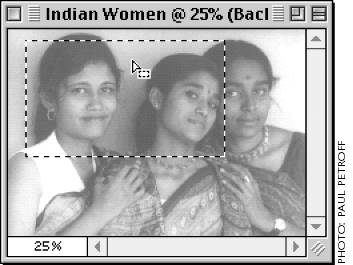
![]() Click inside a selection to deselect it.
Click inside a selection to deselect it.
Note: If you click outside the selection with the Magic Wand, Polygon Lasso, or Magnetic Lasso tool, you will create a new selection.
With any selection tool chosen, right click/Ctrl-click on the image and choose Reselect.
or
With any tool chosen, press Ctrl-Shift-D/Cmd-Shift-D (or choose Select > Reselect).
Tip
If you click a prior state on the History palette that involved a selection, the Reselect command will reselect the selection from that prior state.
If you delete a selection from a layer, the original selection area will become transparent ![]() . If you delete a selection from the Background, the selection area will fill with the current Background color
. If you delete a selection from the Background, the selection area will fill with the current Background color ![]() .
.

![]() A selection deleted from a layer
A selection deleted from a layer

![]() A selection deleted from the Background
A selection deleted from the Background
Press Backspace/Delete.
or
Choose Edit > Clear.
or
Choose Edit > Cut (Ctrl-X/Cmd-X) to place the selection on the Clipboard.
Follow these instructions to move only the selection marquee—not its contents.
Optional: To aid in positioning the marquee, choose View > Show > Grid or drag a guide or guides from the horizontal or vertical ruler. Also, turn on View > Snap To > Guides and/or View > Snap To > Grid.
Choose any selection tool.
Drag inside the selection
 . Hold down Shift after you start dragging to constrain movement to a multiple of 45°.
. Hold down Shift after you start dragging to constrain movement to a multiple of 45°.
 Moving a marquee
Moving a marqueeor
Press any arrow key to move the marquee one pixel at a time.
Tip
You can drag a selection marquee from one image window into another image window using a selection tool.
Tip
If you drag a selection on a layer using the Move tool, the selection’s pixel contents will be cut from that layer and the empty space will be replaced by layer transparency. If a selection is moved on the Background, on the other hand, the empty space will be filled with the current Background color.
With any selection tool chosen, right-click/Ctrl-click and choose Select Inverse.
or
With any tool chosen, press Ctrl-Shift-I/Cmd-Shift-I (or choose Select > Inverse) ![]() –
–![]() .
.

![]() The original selection: The angels are selected.
The original selection: The angels are selected.

![]() After inverting the selection: Now the background is selected.
After inverting the selection: Now the background is selected.
Choose the same command again (or use the same shortcut) to switch back to the original selection.
Tip
It’s easy to select a shape on a solid-color background: Choose the Magic Wand tool, enter 5 or less in the Tolerance field on the Magic Wand options bar, click the solid-color background to select it entirely, then choose Select > Inverse.
Sometimes selection edges (“marching ants”) can be annoying or distracting. To hide them temporarily, follow the instructions below. You can even hide selection edges while some Image menu and Filter menu dialog boxes are open.
Choose View > Show > Selection Edges to uncheck the command. The selection will remain active.
To redisplay the selection marquee, choose View > Show > Selection Edges (it should have a checkmark).
The Ctrl-H/Cmd-H shortcut hides/shows whichever options are currently available on the Show submenu. The Show Extras Options dialog box ![]() (View > Show > Show Extras Options) controls what options are listed on the Show submenu.
(View > Show > Show Extras Options) controls what options are listed on the Show submenu.

![]() In the Show Extras Options dialog box, check or uncheck the onscreen features you want to show/hide using the Ctrl-H/Cmd-H shortcut.
In the Show Extras Options dialog box, check or uncheck the onscreen features you want to show/hide using the Ctrl-H/Cmd-H shortcut.
Tip
To verify that a selection is still active, press on the Select menu. Most of the commands will be available if a selection is active.
Note: The Transform Selection command (discussed below) affects only the selection marquee—not its contents. To transform pixel contents, you can either use a command on the Edit > Transform submenu or you can transform selection contents using the bounding box (see page 138).
With any selection tool chosen, right-click/Control-click on the image and choose Transform Selection from the context menu.
or
With any tool chosen, choose Select > Transform Selection.
Follow the instructions on pages 138–140 to flip, rotate, scale, etc.
 –
– .
.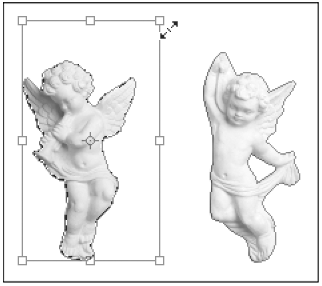
 Scaling a selection marquee
Scaling a selection marquee
 The marquee is enlarged—not its contents.
The marquee is enlarged—not its contents.
Choose Select > Modify > Smooth (see page 132) ![]() or choose Select > Modify > Expand or Contract, enter a value, then click OK.
or choose Select > Modify > Expand or Contract, enter a value, then click OK.

![]() You can use any of the Select > Modify submenu commands to modify an existing selection.
You can use any of the Select > Modify submenu commands to modify an existing selection.
or
Choose Select > Grow or Similar. These two commands use the current Magic Wand Tolerance setting (see page 97). You can repeat either command to further expand the selection.
or
Choose the Magic Wand tool, then right-click/Ctrl-click and choose Grow or Similar.
Choose any selection tool other than the Magic Wand, click the “Add to selection” button on the options bar ![]() , choose other options bar settings for the tool, if desired, then drag across the area to be added
, choose other options bar settings for the tool, if desired, then drag across the area to be added ![]() –
–![]() . (To bypass the “Add to selection” button, position the cursor over the selection, then Shift-drag over the area to be added.)
. (To bypass the “Add to selection” button, position the cursor over the selection, then Shift-drag over the area to be added.)

![]() Use any of these buttons on the options bar to amend a selection.
Use any of these buttons on the options bar to amend a selection.

![]() The original selection
The original selection

![]() After adding an additional selection area
After adding an additional selection area
or
Click the Magic Wand tool, click the “Add to selection” button on the options bar, then click outside the selection. (To bypass the “Add to selection” button, Shift-click outside the selection.)
Choose any selection tool other than the Magic Wand, click the “Subtract from selection” button on the options bar ![]() , choose other options bar settings, if desired, then drag around the area to be subtracted. (To bypass the “Subtract from selection” button, Alt-drag/Option-drag around the area to be subtracted.)
, choose other options bar settings, if desired, then drag around the area to be subtracted. (To bypass the “Subtract from selection” button, Alt-drag/Option-drag around the area to be subtracted.)
or
Click the Magic Wand tool, click the “Subtract from selection” button on the options bar, then click inside the selection. (To bypass the “Subtract from selection” button, Alt-click/Option-click inside the selection.)
With a selection present, choose a selection tool.
Click the Intersect with selection button on the options bar
 , then create a new selection that overlaps the current selection
, then create a new selection that overlaps the current selection  –
– . (To bypass the button, Alt-Shift-drag/Option-Shift-drag.)
. (To bypass the button, Alt-Shift-drag/Option-Shift-drag.)
 A circular selection is drawn over an existing selection with Alt/Option and Shift held down.
A circular selection is drawn over an existing selection with Alt/Option and Shift held down.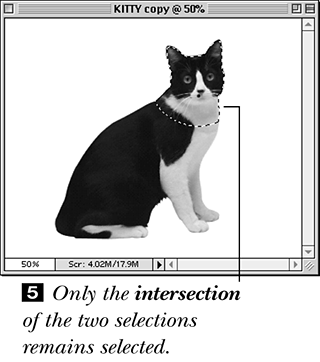
For a multi-layer image, choose a pixel layer, and unselect the Lock: transparent pixels button, if necessary. The vignette you create is going to appear to fade into the layer or layers below it.
For an image with a Background only, choose a Background color (see pages 179–182) for the area around the vignette.
Choose the Rectangular Marquee or Elliptical Marquee tool (M or Shift-M), or the Lasso tool (L or Shift-L).
Enter 15 or 20 px in the Feather field on the options bar. Alternatively, you can feather the selection after it’s created (after step 4) using Select > Feather.
Create a selection
 .
.
 First create a feathered-edge selection.
First create a feathered-edge selection.With the selection tool still chosen, right-click/Ctrl-click on the image and choose Select Inverse.
Press Backspace/Delete.
Right-click/Ctrl-click on the image and choose Deselect
 –
– .
.
 The vignette
The vignette
 The original image (Peter’s relatives—no kidding)
The original image (Peter’s relatives—no kidding)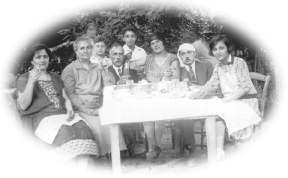
 The vignette
The vignette
 For this image, we applied the Glass filter after step 5.
For this image, we applied the Glass filter after step 5.
If you’ve ever torn your hair out trying to mask a shape with an irregular edge (a figure with curly hair or an animal in a landscape), you’ll appreciate the Extract command. The nicest thing about this feature is that you’ll create the mask on a full-size preview right in the dialog box ![]() , so you can tweak it until you’re certain you’ve got it just right. When you click OK, the masked area will be preserved, and the remaining areas will be erased to transparency.
, so you can tweak it until you’re certain you’ve got it just right. When you click OK, the masked area will be preserved, and the remaining areas will be erased to transparency.

![]() After outlining the chimp with the Edge Highlighter tool and filling the interior of the chimp with the Fill tool.
After outlining the chimp with the Edge Highlighter tool and filling the interior of the chimp with the Fill tool.
Note: For safety’s sake, work on a copy of the image—or at least on a duplicate layer. You could also make a snapshot of the original image.
Choose the layer from which you want to extract imagery.
 Choose Filter > Extract (Ctrl-Alt-X/Cmd-Option-X). A full-screen, resizable dialog box will open.
Choose Filter > Extract (Ctrl-Alt-X/Cmd-Option-X). A full-screen, resizable dialog box will open.You’ll use the Edge Highlighter to mask the object border first, and then click on the interior with the Fill tool to define the fill.
Choose the Edge Highlighter tool from the toolbox in the dialog box (B)
 .
.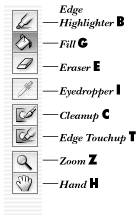
 Tools and tool shortcuts in the Extract dialog box
Tools and tool shortcuts in the Extract dialog boxand
In the Tool Options area
 , enter or choose a Brush Size in pixels for the marker. The sharper the edge of the object you’re going to extract, the smaller the brush you can use. Use a large brush if the shape has wide, choppy edges.
, enter or choose a Brush Size in pixels for the marker. The sharper the edge of the object you’re going to extract, the smaller the brush you can use. Use a large brush if the shape has wide, choppy edges.
and
Choose Red, Green, or Blue as the Highlight color for the mask. Or choose Other and choose a color from the Color Picker.
Optional: If you’re going to trace a crisp-edged shape (e.g., a geometric shape), check Smart Highlighting. The highlight will be the minimum width necessary to cover the edge of the shape, regardless of the current brush size.
Drag around the border of the area of the image you want to extract. Complete the loop to make a closed shape. Drag right along the object’s border so as to catch any frizz or fringe. You don’t need to drag along the edge of the canvas area if the imagery extends that far.
Optional: Raise the Extraction: Smooth value to eliminate extraneous pixels.
Choose the Fill (second) tool (G) from the toolbox in the dialog box.
and
Choose Red, Green, or Blue as the Fill color for the mask. Or choose Other and choose a color from the Color Picker.
and
Click on the area of the image that you want to extract. (Click again to un-fill.)
Note: To extract pixels of one color, instead of using the Fill tool, check Force Foreground, choose the Eyedropper tool in the dialog box (I), then click a color in the preview window. Or click the Color swatch and choose a color from the Color Picker.
Use the Eraser tool (E) from the dialog box if you need to unmask any masked areas. Choose a Brush Size for the Eraser in the Tool Options area of the dialog box.
Click Preview, then in the Preview area of the dialog box, do any of the following:
Check Show Highlight and/or Show Fill.
Choose Show: Extracted to toggle to the extracted image view; choose Original to toggle back to the original image.
Choose Display: None to display the background as transparent; choose Black Matte, Gray Matte, or White Matte to display the extracted shape on a background of black, gray, or white, respectively; choose Other to choose a custom color; or choose Mask to display the discarded area as black and the protected area as white.
To refine the mask further, do any of the following:
Use the Cleanup tool (C) to gradually subtract opacity. (Alt-drag/Option-drag to restore opacity.)
Use the Edge Touchup tool (T) to gradually sharpen edges.
Change the Smooth value.
Click OK. If you want to restore lost areas now, use the History Brush tool
 –
– (see pages 160–161). Or to erase further by hand, use the Background Eraser (see pages 228–229).
(see pages 160–161). Or to erase further by hand, use the Background Eraser (see pages 228–229).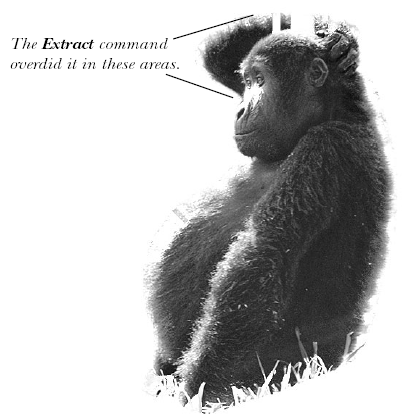
 After extracting (chimp not in the mist)
After extracting (chimp not in the mist)
